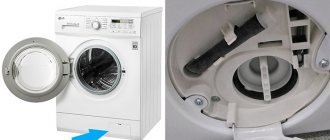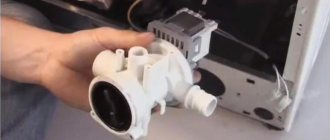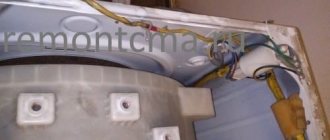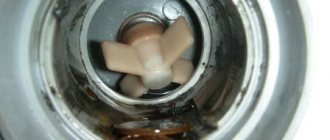Washing machines have become a part of our everyday life, and today Russian families no longer think about the fact that recently washing was a very troublesome and time-consuming process. Only a sudden breakdown of equipment can make you remember how your parents or grandparents used to do laundry by hand. Lack of water drainage is one of the most common washing machine malfunctions, with which users turn to service centers for help.
Unfortunately, it is almost impossible to predict when a breakdown will occur and take appropriate measures. The machine can work properly for several years and suddenly stop with laundry and water without completing the washing program. This causes the owner a lot of inconvenience and makes him urgently rack his brains over the question: “How to drain the water and get things out of the drum?” Since anyone can find themselves in a similar situation, this article will discuss ways to solve this problem.
How to properly clean the filter and drain the water
Washing machines of different brands have their own design features; there are built-in models and devices with vertical loading of laundry. However, almost all manufacturers place the drain filter at the front bottom of the device, next to the pump. Access to the unit is closed by a removable panel or hatch, which can be easily opened if necessary.
This arrangement of parts is not accidental: equipment manufacturers provide the possibility of emergency drainage of water through the hole in the drain filter. Before starting the procedure, you need to turn off the power to the machine and turn off the water. This is done for safety reasons to prevent electric shock from spilled water. Then you should remove the protective panel or open the hatch cover. If you cannot complete this or subsequent steps, please refer to your machine's instructions for help.
It’s worth preparing some flat dishes and a rag in advance to prevent water from spilling onto the floor. Many manufacturers have made the draining process comfortable by providing a special emergency hose for this purpose. If it is missing, you need to be prepared for the fact that some of the water will end up on the floor.
To get to the filter, you need to remove the cover or plug by carefully turning it 45-60 degrees counterclockwise. Then the filter element itself is unscrewed or pulled out (depending on the model). After this, the part and the place where it was removed are thoroughly cleaned of debris and washed. Next, the filter is installed in place and the locking lid is closed.
If the washing machine has stopped and is stuck with clothes, you also need to remove the clothes from the drum. First, the device is disconnected from the power, then it is forced to drain. In addition to access through the filter hole, on most models you can remove water from the tank by simply lowering the drain hose as low as possible. When the machine is unplugged, it will soon unlock the hatch and make it possible to remove the laundry.
Problems removing the filter
But filter removal is not always easy. It is rare, but it happens that foreign objects, hair, coins or hairpins that get into the drain block the part and prevent free twisting. Sometimes the nozzle “sticks” to the body of the washer due to a thick layer of limescale or widespread rust.
If the filter does not unscrew according to the previously described scheme, then you will have to work a little harder. There are three working methods by which you can remove even a tightly stuck spiral. However, it is better to act consistently and start with the most gentle, first one, gradually increasing the pressure.
Before unscrewing the drainage filter, the washing machine must be de-energized and disconnected from the water supply and sewage system!
- Tools. If you can’t unscrew the filter by hand, then try repeating the procedure using pliers. You need to “grab” the protrusion and rotate the nozzle. We increase the pressure gradually so as not to break the spiral.
- Tapping. In cases where the filter does not scroll at all, not all the way, or, having unscrewed, cannot be removed from the hole, you should proceed differently. We tilt the equipment back, lean it against the wall and knock several times with our fist on the drainage cover and next to it. The spiral is probably blocked by a stuck object, which may move after knocking.
- Path through the pump. If the first two methods do not help, you will have to proceed in the most labor-intensive way - remove the filter from the pump. You need to get to the pump, unhook it from the volute, and push the spiral out through the free hole.
The design of Atlant washing machines allows you to dismantle the pump through the bottom, which greatly simplifies the task. It is enough to turn the machine on its right side, remove the pan and, using a flashlight, find the pump. It is easier to determine its location using the filter, since the part is located directly behind it.
You should only try to remove a stuck filter if you have the desire, strength and experience. For those who are not well versed in technology, it is better not to experiment, but at the first difficulties, contact a service center. Otherwise, you can aggravate the situation and damage the attachments.
Interesting:
- Replacing and cleaning the dishwasher filter
- Cleaning an Electrolux washing machine
- How to clean the drain pump filter of a washing machine...
- Cleaning a Zanussi washing machine
- Cleaning the drain pump in a washing machine with your own hands
- Cleaning the Ardo washing machine filter
Reader comments
- Share your opinion - leave a comment
Other reasons for slow drainage
A clog at the filter level is a common, but not the only reason for slow or non-existent drainage. Quite often it is caused by a malfunction of the pump (pump), problems with the pressure switch (water level sensor) or malfunctions of the control module. Sometimes it happens that water is drained on some programs, but not on others. In this case, the mechanical components of the device are working properly; the problem should be looked for in the electronics.
Drain pump failure
The pump is responsible for pumping dirty water from the tank through a system of pipes and hoses directly into the sewer. The pump is usually installed at the bottom of the machine, under the tank. This arrangement allows the device to optimally perform its function. Over time, the pump, like the drain filter, may become clogged, and then the water will drain very slowly. When metal objects (keys, coins, buttons) enter the drain system, they often break the impeller blades or damage the pump body. A complete lack of drainage most often indicates a violation of the integrity of the pump or combustion of the motor as a result of voltage surges.
Problems with the water level sensor
A faulty pressure switch can also cause a lack of drainage and malfunctions in the washing machine. Thanks to this sensor, the electronics “see” whether there is currently enough water in the tank to complete the wash. If the pressure switch measures the level incorrectly or does not receive signals from it at all, the program will freeze. It is better to replace a broken sensor, since washing its tube or cleaning the contacts usually helps for a short time, and the user again faces inconvenience.
Electronics malfunction
This breakdown is somewhat less common than the ones listed above. However, it is this that is the most difficult and expensive to eliminate. All processes in the machine are controlled by an electronic module; it is this module that activates the pump. At the right moment, a command is given to turn on the pump, and when all the liquid is pumped out of the tank, a signal to turn off is given. If the wiring or triac of the pump burns out, the connection between the nodes is interrupted, and water will not be drained, even if the pump is working.
Such repairs are not cheap, because the repairs are carried out by highly specialized electronics specialists. But they, as a rule, give a guarantee on their work for a month or two. After this period, the problem may return. In addition, it is not always possible to restore a damaged control unit, and replacing it is impractical due to the high cost of the spare part itself. Therefore, if you have such problems with electronics, you should seriously think about buying a new washing machine.
Can't unscrew
Sometimes it is not possible to unscrew and remove the filter due to various objects stuck in it. Hair, socks and handkerchiefs, coins, beads and other small items during washing can end up in the catcher in front of the pump and plug it. Limescale deposits on the threads, which occur if the filter has not been removed for a long time, can also become an obstacle.
In this case, there are three ways to open the garbage filter. Apply them in turn, proceeding to the next method only if you tried the previous one and it did not help. Before you begin, be sure to unplug the machine and close the valve to prevent water from flowing.
1 way. Use pliers or pliers to unscrew the filter cap. There is a handle on it that you need to try to turn using a tool. Manipulations should be carried out very carefully so as not to break the filter part.
Method 2. Lightly tap the drain pump filter cover several times while tilting the washing machine. This method is suitable when:
- The garbage filter cover does not rotate at all;
- partially rotates;
- It can be unscrewed, but it cannot be removed.
Tilt the machine back and lean it against the wall. Tap the dust filter cover and the housing next to it. If the snag is in small objects that have stopped the desired part, then the knock will cause them to move, and you can unscrew and pull out the filter.
3 way. If the previous two methods were unsuccessful, then you need to completely remove the drain pump. The task is to clean the snail and remove the filter. This method is quite complicated - you need to get to the pump, unhook the pump from the volute and through the resulting hole get to the filter.
The design features of certain models of Kandy washing machines allow the drainage pump to be dismantled through the bottom. If it is easily removed or is absent altogether, then it is easier and more convenient to get the snail with the pump in this way. Putting the machine on its side or simply tilting it in the desired direction and resting it on the wall, remove the bottom and find the pump. It is located behind the filter, that is, in the lower part of the housing.
The listed methods should only be used if you are confident in your abilities and have certain skills in repairing various devices. If the filter does not unscrew and you are not very well versed in technology, it is better to call a specialist. It must be remembered that through ignorance you can not only waste time, but also worsen the situation.
Interesting:
- Washing machines Candy
- Review of Candy washing machines
- Cleaning the filter in the Ariston washing machine
- Review of narrow Candy washing machines
- Cleaning the Ardo washing machine filter
- Review of gas stove with dishwasher and/or oven
Reader comments
- Share your opinion - leave a comment
How to prevent filter clogging?
In addition to drainage problems, bacteria can grow in the dirt on the filter element. Following this, an unpleasant odor appears, which will penetrate into the tank and be transmitted to the laundry. Manufacturers of washing machines recommend performing preventive filter cleaning on average once every 2-3 months. The frequency of repetition of the procedure directly depends on the frequency of washing and the type of fabric. For example, when washing woolen and pile items, cleaning must be done very often, almost once a week. It is also necessary to check the pockets of your clothes before washing for the presence of various items in them.
Cleaning the filling pump filters
Before any manipulations with the Atlant washing machine, you must perform the following steps. First of all, disconnect it from the power supply, then turn off the water supply tap. These are safety rules to prevent flooding and electric shock.
Filters in the washing machine
The Atlant washing machine pump filters are located in the inlet hose, as well as in the threaded pipe of the solenoid valve. These structures prevent the penetration of various mechanical impurities - sand, metal shavings - into the Atlant washing machine from the central water supply system. Foreign inclusions in running water, when deposited on filters, impair the water supply.
Washing machine pump filter
Sequencing:
- Turn the nuts counterclockwise, remove and disconnect the inlet hose from the water supply tap and the threaded pipe of the solenoid valve.
- Remove the pump filters. For convenience, use tweezers or pliers.
- It is recommended to clean with a brush. Additionally, rinse under running water.
- We connect the spare parts in reverse order.
Washing machine Atlant
Note! The filling pump filters need to be cleaned once a year. In order not to forget, you can put a sticker on the case indicating the next date.
New Miele washing machines - high-quality and economical
Miele rightfully occupies a leading position in the production of premium household appliances. The distinctive features of German brand washing machines are versatility and high reliability, ease of operation and environmental friendliness. Thanks to the functionality and design thought out to the smallest detail, Miele devices fit harmoniously into any modern interior, embodying the pinnacle of scientific and technological progress.
The company's engineers and designers do not stop working on modernization, striving to make the already almost ideal equipment even better. The machines use Miele's patented innovative technologies and materials, for example: the economical ProfiEco engine, TwinDos and CapDosing intelligent detergent dosing systems, as well as a unique honeycomb drum, which is installed on all Miele washing and drying machines.
The honeycomb drum ensures high quality washing, while protecting even the thinnest fabric from damage. The holes for water drainage on its walls are very small, so even during spinning at high speeds, pills and puffs will not appear on your favorite clothes. In addition, this design eliminates the possibility of small objects getting into the drain system. Thanks to this, the pump will not fail prematurely, and only the smallest debris will be retained on the filter, which cannot cause a serious breakdown.
Unique design and rich set of different programs
The Miele washing machine range includes built-in and free-standing devices with both front and top loading. Integration into the interior of any modern kitchen or bathroom is thought out to the smallest detail. Various installation options are available: in a column or Side-by-Side together with a drying machine, as well as built-in under a countertop.
The devices are equipped with intuitive touch controls with a large digital display and the ability to network with other equipment, as well as a spacious drum designed to load from 6 to 9 kg of laundry (depending on the model). The modern electric motor operates very quietly, the spin speed is up to 1600 rpm. Thanks to innovative technological solutions, all Miele appliances are even more economical than required for energy efficiency class A+++.
The functionality of washing machines from the German company is impressive; they will satisfy any needs and desires of the most sophisticated buyer. It supports several dozen automatic washing programs and many additional functions for comfortable and safe operation. There are special modes for caring for cotton and delicate fabrics (including silk, wool, cashmere), pillows and bed linen, there are programs for denim, outerwear, sportswear, children's clothing and a number of additional options.
By purchasing a new Miele brand washing machine, you get at your disposal a modern, without exaggeration, smart device with an elegant design that will work for many years without breakdowns, thereby justifying traditional German quality.
Premium service in our online store
Our branded online store sells original Miele household appliances in the Russian Federation. You can get acquainted with the range of VIP-class washing machines and order the model you like directly on this website through the online form or by calling the specified contact numbers.
All household appliances are covered by an extended warranty from the manufacturer - 24 months. A list of authorized Miele service centers located in all major cities of Russia can be opened by following the link from the “Warranty” page on our website. There you can leave a request for equipment maintenance or a request for spare parts and accessories for it. Delivery of goods throughout Moscow, St. Petersburg and regions of Russia is provided.











